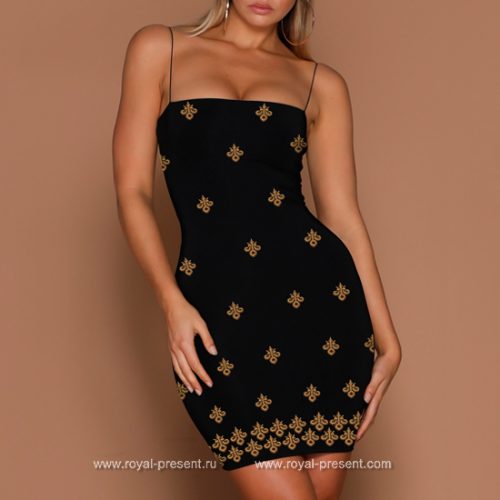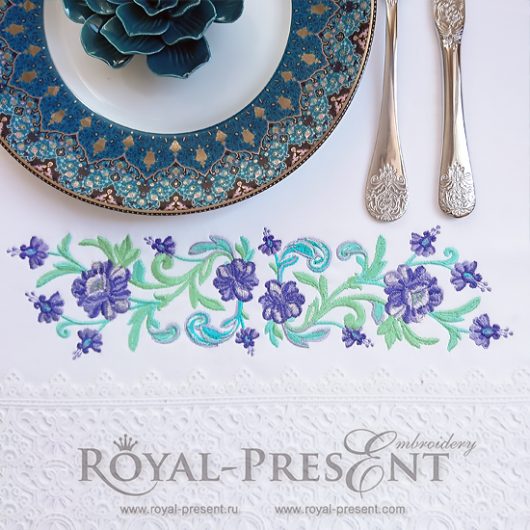This original and unique Classic elements machine embroidery designs will add to your garment sophistication, and for your home textile – luxury.
You can use it for different purposes. So, you can create embroidered summer dresses, which elegantly fit for everyday using, and for more festive events. It all depends on the type and color of the fabric and the choice of the embroidery color pattern of embroidery. For example, if you embroider this design on a white background with the color Plum or Dark Magenta, or Crocus you will get a wonderful sarafans in a casual style. If you use more noble colors, such as Military gold or Gold Rush, or Golden Nugget on a black background, then this dress will look elegant, and perfect for a party or a secular reception.
A great idea is to use this machine embroidery patterns for pillowcases and bedclothes. For example, the border can be embroidered on the top or bottom of the duvet cover and the sheets, and the design itself is beautifully scattered throughout the fabric. You can also use white and white embroidery, or color by color. Such bedclothes will also look noble.
When embroidering such machine embroidery patterns for pillowcases, you can use satin as a fabric. Satin pillows and bedclothes were always appreciated for its refinement, tenderness and pleasant tactile sensations for the people`s skin. To sleep in such bed is a pleasure.
It’s no secret that many embroiderers do not favor satin fabric for embroidery. But in fact, to achieve high-quality embroidery on satin is not so difficult.
Classic elements machine embroidery designs
Size: 97.3×61.8 mm (3.83×2.43 “), Stitches: 9090
Size: 26.5×31.6 mm (1.04×1.24 “), Stitches: 1500
Formats: .dst, .jef, .pec, .vip, .hus, .pes, .exp, .sew, .dat, .vp3, xxx
The main difficulty for embroiderers is that the fabric is very slippery and tender. It is easily damaged (like organza and tulle) at the moment of hooping.
In order to properly embroider on a satin, you should:
• Hoop the fabric with the stabilizer. You should do it very accurate and try to avoid the contact of hoops with the fabric. Try to turn the hoop.
We recommend you to use water-soluble self-adhesive Filmoplast on the fabric and glue it on the satin fabric.
• Use a cut-off medium stabilizer.
• In order to avoid minor mechanical damage to the fabric, you can avoid hooping the satin fabric. To do this you can hoop the stabilizer, and then place the fabric on it with the help of fabric glue stick. In order to satin fabric not to get peel off from the base, you can do additional stitches along the perimeter of the hoops.
• Threads can be used of all types, but we recommend you using viscose ones.
• Choose the needle according to the thickness of the fabric and the type of thread.
We recommend using a needle with a light round tip type (SES) for viscose threads.
By following these rules, you can easily embroider this Classic elements machine embroidery designs on satin. By the way, it can be used not only for bedclothes, but also satin pajamas, T-shirts and shorts.
Proven advice from Royal Present: It’s no secret that there are cases when the fabric slips out from ordinary square hoop. Basically, it happens in weakened places, in the center of each side of the hoop. In these places, the gap between the rings is the largest. This is especially noticeable for embroidery on slippery fabrics (silk, satin). But you can prevent slippage of fabric from the hoop. To achieve this you can use a special quilters “no-slip” hoop tape of Edmunds production. It consists of semi-adhesive and rubber sides. You need to place the first of it to the inside of hoop. Thus, the rubber side will contribute to the tight clamping of the fabric. The tape leaves no traces on the fabric. It is perfectly removed and can be used for both wooden and plastic hoops.
You may also like
Machine Embroidery Design Emerald border

Author: Ludmila Konovalova
My name is Ludmila Konovalova, and I lead Royal Present Embroidery. Embroidery for me is more than a profession; it is a legacy of my Ukrainian and Bulgarian heritage, where every woman in my family was a virtuoso in cross-stitch and smooth stitching. This art, passed down through generations, is part of my soul and a symbol of national pride.
Date: 26.02.2018




 Get Sign-In Link
Get Sign-In Link Login with Google
Login with Google Login with Facebook
Login with Facebook Login with Amazon
Login with Amazon Login with Paypal
Login with Paypal